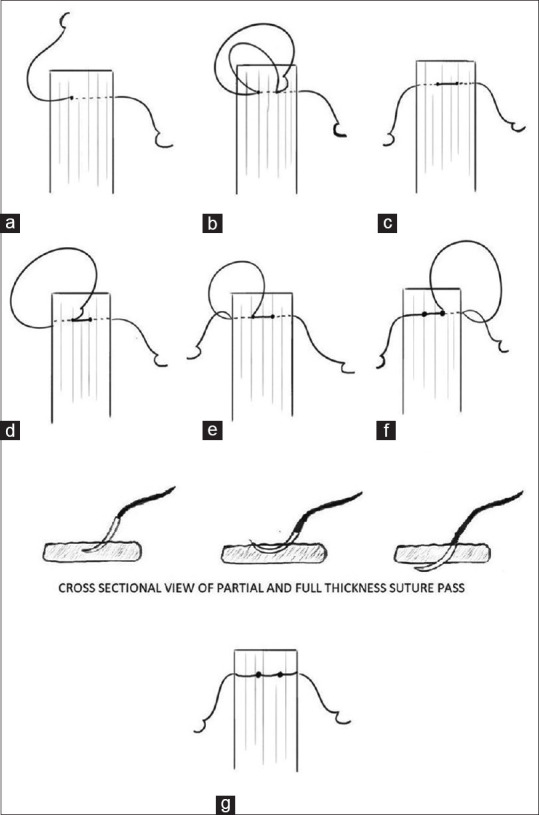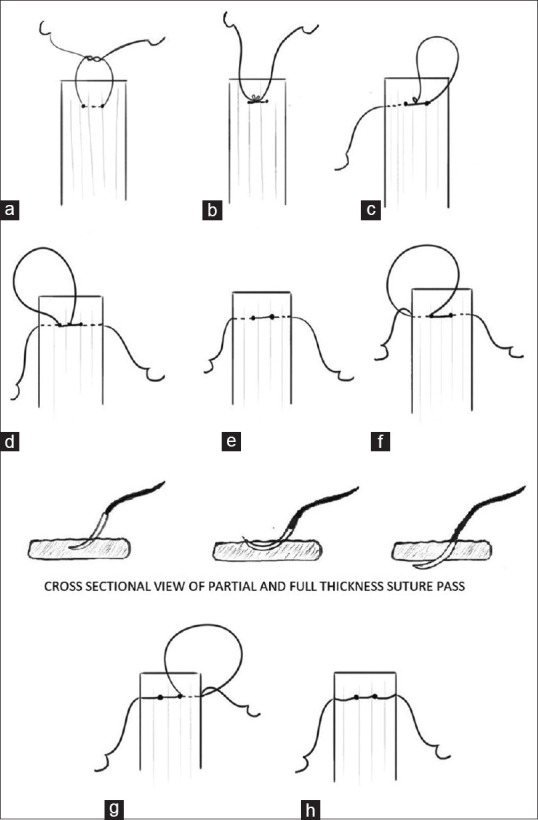Sutures and suturing techniques form a vital part of strabismus surgery.
The dreaded complication of “slipped muscle” can be averted with good muscle suturing techniques. The authors of this article have done a commendable job in developing new muscle suturing techniques. Their description of each technique is clear, and the illustrations make it easier for the reader to understand the techniques better.[1] We would like to discuss this article under two aspects. The first one being the muscle suture technique and the second being if using half a suture will cut down the cost of strabismus surgeries.
When we review the suturing techniques, each surgeon has his or her way of securing the muscle. The most common ones are the technique where the lateral halves of the muscle are secured with a single-arm suture and the three-point fixation technique with a double-arm suture.[2]
In our experience, the three-point fixation technique using double-arm sutures is found to be extremely safe and effective because it secures the muscle completely but in parts (i.e., the central one third and the lateral one third of the muscle).
The three-point fixation technique that we practice for recession and resection is illustrated below for our readers to understand better. In both the procedures, the central one third of the muscle is secured first followed by the lateral one third of the muscle with a double arm 6-0 vicryl suture.
During muscle recessions, the central one third of the muscle is first secured with a double throw stitch as shown in the illustration below [Fig. 1 a-c] followed by the lateral one third of the muscle through partial thickness and full thickness locking sutures [Fig. 1 d-g].
Figure 1.

Steps of muscle recession using double arm 6-0 polyglactin suture. (a) Suture bite at two-third and one-third junction of the muscle. (b) Central double throw stitch. (c) Central one-third muscle secured. (d) Suture bite at the lateral one-third of the muscle. (e) Partial thickness locking suture. (f) Full thickness locking suture. (g) Muscle secured by 3 point fixation technique
During muscle resections, the central one third of the muscle is secured first with an approximation knot followed by a securing knot [Fig. 2a and b]. The knot is then buried [Fig. 2c and e]. This is followed by securing the lateral one third by partial thickness and full thickness locking sutures [Fig. 2g and h].
Figure 2.

Steps of muscle resection using double arm 6-0 polyglactin suture. (a) Securing the central one-third of the muscle with approximation knot. (b) Securing knot. (c) Burying of the knot. (d and e) Partial thickness suture bite to secure lateral one third of the muscle on either side. (f) Partial thickness locking suture. (g) Full thickness locking suture. (h) Muscle secured by 3 point fixation technique
The central stitch prevents slippage of the muscle and central sagging of the muscle ensuring the muscle is held in its place. We have been using this technique for about 20 years now, and it has given us good results even in the hands of novice surgeons. But then again, it is the surgeon’s preference that matters, and it does not imply that the other techniques are not successful.
The three-point fixation technique using half of the double arm suture by the authors of this article is noteworthy as it enables strabismologists to practice a safe and effective technique in addition to economizing strabismus surgeries. These techniques may perhaps have a learning curve but can be positively put to practice. However, when it comes to economizing the cost of strabismus surgeries, we believe that the suture costs can also be lowered by using sutures manufactured by Indian companies, which are durable and equally effective than those manufactured by other foreign companies. By doing so, the surgeons are not compromising on their preferred choice of technique as well.
All said and done, every surgeon must keep in mind that in an attempt to economize strabismus surgeries by limiting the usage of suture material, the surgical outcome should not be compromised, as the ultimate aim of using the right amount of suture with a good suturing technique is to secure the muscle in the desired fashion to achieve the best postoperative outcome.
The authors have no financial or proprietary interest in any of the methods or materials used in this study.
References
- 1.Kauser F, Amitava AK, Saxena J, Raza SA, Masood A. Economizing strabismus surgery: Using half the double-armed suture for horizontal muscles. Indian J Ophthalmol. 2021;69:1945, 7. doi: 10.4103/ijo.IJO_2869_20. [DOI] [PMC free article] [PubMed] [Google Scholar]
- 2.Helveston EM. Surgical Management of Strabismus. 5th ed. Wayenborgh publisher; 2005. [Google Scholar]


